Based on this picture of JCommandButtonStrip:

I think you are looking for JToggleButton as @trashgod suggested, but I'm not sure about buttons group given the current description of your "problem". If you need buttons group then use it.
Anyway my answer points to this line:
This could be based on a pre-configured JCommandButtonStrip (some info
here) but exposing exactly the same API of JCheckBox.
Once again it's not clear if you're trying to do a buttons bar such as JCommandButtonStrip or you want to do something else. However you can make your own component extending from JComponent and delegate only those methods that are needed from the outside. For example let's say you want to do a buttons bar such as JCommandButtonStrip. Then you can have:
- One class extending from
JComponent: your buttons bar.
- Another one providing an API to add "commands" to the buttons bar.
Note: There's already a JToolBar component which can perfectly be used without reinvent the wheel. The example below is just to show you that you can control the API offered to the developers.
MyCommandBar.java
import java.awt.FlowLayout;
import java.awt.Graphics;
import java.awt.GridLayout;
import java.awt.event.ActionListener;
import java.util.HashMap;
import java.util.Map;
import javax.swing.AbstractButton;
import javax.swing.Action;
import javax.swing.Icon;
import javax.swing.JButton;
import javax.swing.JCheckBox;
import javax.swing.JComponent;
import javax.swing.JPanel;
import javax.swing.JToggleButton;
import javax.swing.event.ChangeListener;
public class MyCommandBar extends JComponent {
private final JPanel content;
private final Map<String, CommandItem> map = new HashMap<>();
public MyCommandBar() {
super();
content = new JPanel(new GridLayout(1, 0));
content.setOpaque(false);
setLayout(new FlowLayout());
add(content);
}
@Override
protected void paintComponent(Graphics g) {
super.paintComponent(g);
Graphics graphics = g.create();
graphics.setColor(getBackground());
graphics.fillRect(0, 0, getWidth(), getHeight());
graphics.dispose();
}
public void addCommandItem(String actionCommand, CommandItem commandItem) {
if(map.get(actionCommand) != null) {
removeCommandItem(actionCommand);
}
content.add(commandItem.getComponent());
map.put(actionCommand, commandItem);
}
public void removeCommandItem(String actionCommand) {
CommandItem commandItem = map.get(actionCommand);
if(commandItem != null) {
content.remove(commandItem.getComponent());
content.revalidate();
content.repaint();
map.remove(actionCommand);
}
}
public CommandItem getCommandItem(String actionCommand) {
return map.get(actionCommand);
}
public static class CommandItem {
public static final int TOGGLE_BUTTON_STYLE = 0;
public static final int CHECK_BOX_STYLE = 1;
public static final int DEFAULT_BUTTON_STYLE = 2;
private final AbstractButton component;
public CommandItem(String text, boolean state, Icon icon, int style) {
switch(style) {
case TOGGLE_BUTTON_STYLE : component = new JToggleButton(text, icon, state); break;
case CHECK_BOX_STYLE : component = new JCheckBox(text, icon, state); break;
default: component = new JButton(text, icon);
}
}
protected AbstractButton getComponent() {
return component;
}
public void addActionListener(ActionListener listener) {
component.addActionListener(listener);
}
public void addChangeListener(ChangeListener listener) {
component.addChangeListener(listener);
}
public void setAction(Action action) {
component.setAction(action);
}
}
}
Example of use
This code snippet shows how MyCommandBar class should be used:
MyCommandBar commandBar = new MyCommandBar();
commandBar.setBorder(BorderFactory.createLineBorder(Color.black, 1));
commandBar.addCommandItem("BOLD", new MyCommandBar.CommandItem("<html><b>Bold</b></html>", true, null, MyCommandBar.CommandItem.TOGGLE_BUTTON_STYLE));
commandBar.addCommandItem("ITALICS", new MyCommandBar.CommandItem("<html><i>Italics</i></html>", false, null, MyCommandBar.CommandItem.CHECK_BOX_STYLE));
commandBar.addCommandItem("UNDERLINE", new MyCommandBar.CommandItem("<html><u>Underline</u></html>", false, null, MyCommandBar.CommandItem.DEFAULT_BUTTON_STYLE));
And you'll see something like this:



